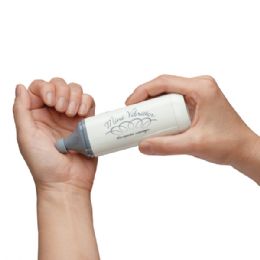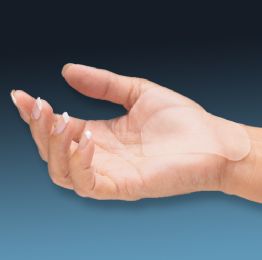
Scar treatment involves the use of medical devices or products that break up abnormal densities in scar tissue to help heal and manage scarred areas of the skin. These treatments also aid in relieving itchy and dry skin issues, while they also help guard against moisture loss.
Rehabmart is pleased to offer a wide selection of superior performance scar treatment products and devices from innovative and well-known vendors that include Sammons Preston, North Coast, DeRoyal, Independence Medical, McKesson Medical-Surgical, Corrective Concepts, RangeMaster, and Fabrication Enterprises.


What is a Scar?
A scar is the result of a biological process of wound repair, creating a fibrous tissue that replaces normal skin after an injury. With the exception of minor lesions, almost every wound will result in some degree of scarring. All scarring is composed of the same collagen as the surrounding skin, or tissue, and helps to reconnect the tissues and skin broken apart by the injury.
How Does a Scar Form?
After an injury to the skin, the skin goes through three stages of repair before a scar is formed. During the first stage there is swelling, tenderness or pain, and redness as a scab begins to form over the damaged area. During the second stage, new skin tissue starts to form underneath the scab, and the final stage includes the rebuilding and reforming of the inner and outer layers of the skin.
There are three main types of scars: raised, flat, or indented. The two most common types are hypertrophic and keloid scars. Both of these types of scarring develop excessively stiff collagen bundled growths that overextend the tissues, blocking off future regeneration of these tissues.
Hypertrophic scars occur when the body overproduces collagen, taking the form of a deep red to purple raised lump on the surface of the affected skin, usually within four to eight weeks following wound closure or wound infection. Although similar to keloid scarring with the look of raised, red scarring, a hypertrophic scar does not go beyond the boundary of the wound or injury. Raised scarring can flatten over time but can still take years to resolve. Scarring is more noticeable around body joints where the movement is more active and skin tension high, causing decreased ability to move at the affected area. This type of scarring is also referred to as contracture scars.
Keloid scars are the result of the body’s overly aggressive healing process, and can extend beyond the original injury, growing indefinitely into large, benign, tumorous neoplasms. Keloid scars can occur on anyone but is most common in people with dark skin pigmentation. While keloid scars can form spontaneously, they are usually caused by wounds associated with accidents, surgery, acne, and even body piercings. Although completely harmless and not cancerous, keloid scars can become a cosmetic problem due to their inert masses of collagen. Over time, a keloid scar may hamper movement at the site of the scarring.
Atrophic scars show a pitted appearance formation of a sunken recess in the skin caused when underlying support structures, such as muscle or fat, are lost. Atrophic scarring is often associated with chickenpox, acne, surgery, accidents or other diseases such as Staphylococcus or MRSA infections. Other names for this type of indented scarring are pockmarks, depressed scars, and ice pick scars. Due to the destruction of the underlying support structure of the skin, this type of scarring doesn’t heal as well as raised or flat scars.
Acne scars occur when hair follicles become clogged with oil and dead skin. These scars can range from deep pit scars (see atrophic scars) to scars that are angular or wavelike in their appearance. Often characterized by areas of pimples, whiteheads, greasy skin, and blackheads, acne occurs mostly during adolescence but can also occur, although less common, in adulthood. Almost half the people in their twenties and thirties continue to experience acne, as well as a small percentage of people in their forties. Genetics, more than diet or cleanliness, is thought to be the root cause in about 80% of acne cases.
Stretch marks, or striae, is a type of scarring caused by skin that is rapidly stretched by such instances as pregnancy, adolescent growth spurts, significant weight gain, or skin tension during the healing process, usually occurring around body joints or other moving or stretching areas of the body. This type of scarring will usually improve or fade in its appearance after several years.
Effective Scar Treatments and Their Benefits
Silicone gel sheets – Pieces of thin, flexible medical grade silicone sheets are used on healing skin (not open wounds), and are commonly utilized in preventing hypertrophic or keloid scar formation, or to improve an existing scar’s appearance. Placed over the scar area for at least 12 hours a day for at least three months, the gel sheets moisturize the area to help decrease dryness and itching, and are durable and comfortable enough to wear alone or in conjunction with pressure garments, casts, or splints.
Pressure dressing or garments – Most often used after skin grafts or on large burn scars, pressure dressings/garments help to flatten and soften scars. Used either alone or in combination with silicone gel sheeting, a pressure dressing should be worn over a scar 24 hours a day for between 6 to 12 months, to help improve the appearance of the scar.
Skin creams – Also known as healing creams, specific skin creams are often recommended for self-management of scars. Massaging the scar area with skin cream that contains vitamin E can keep the scar from becoming dry, making it supple and lessening the skin tension, especially in the body’s joint areas.
Skin needling – Also called micro-needling therapy, percutaneous collagen induction (PCI), or collagen induction therapy (CIT). This therapy utilizes a small medical rolling device that is covered in hundreds of tiny needles, and it is rolled over the affected scar and skin area. As a minimally invasive skin rejuvenation procedure, the needles are used to puncture the skin, creating a controlled skin injury. As each very fine needle punctures the skin, it creates a micro-wound, or channel, triggering the body’s natural response to produce new collagen and elastin in the papillary dermis to fill the micro-wounds, while also forming new capillaries that carry revitalizing blood and oxygen to the affected area. This treatment leads to the reduction of scars and enhances skin rejuvenation. This treatment is often applied to reduce hypertrophic scars caused by surgery, thermal burns, or acne, as well as helping with the fading of stretch marks, reducing fine lines and deep wrinkles, and tightening sagging skin.
Massage devices – Medical devices that help soften and desensitize the scar area. These precision-engineered therapy instruments can glide over the skin’s surface to detect soft scar-tissue, and treat it by breaking up the abnormal collagen densities, initiating the healing process. When combined with stretching, a scar massager can help make the scar looser, softer and more comfortable, allowing the skin to become more pliable.
Scar suction pump – A medical device that is a partial vacuum which creates negative external pressure, drawing the skin away from internal tissue adhesions, increasing the range of motion of the affected area.
Some other treatments for scars can include, but are not limited to:
Corticosteroid injections
Surgery
Make-up for scars
Laser or light therapy
Dermal fillers
Radiotherapy
Hulet Smith, OT
Rehabmart Co-Founder & CEO
ws